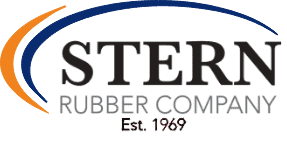3D printing or Additive Manufacturing (AM) is a technology that creates parts from a wide variety of materials in which the parts are formed layer by layer by an additive process, unlike the original more traditional methods of creating parts by a molding or casting process. The types of material that work best for 3D printing are plastics, metals, paper, ceramics, bio materials and even food. Although there are many different materials for 3D printers, Stern Rubber Company uses an ABS plastic composite material on their Makerbot 3D printer, which prints layer by layer at a micro layer at a time. Stern Rubber typically uses our Makerbot to create fixtures to hold our rubber parts and extrusions.
3D printing first started in the late 1980’s. The earlier process was called Rapid Prototyping technologies (RP). The first rapid prototyping machine was invented in 1980 in Dr. Kodoma, a patent lawyer in Japan. He did not complete the patent application within the one-year deadline, so he wasn’t awarded the first patent. The first patent was issued in 1986 to Charles Hull, for a sterolithography apparatus machine that he had been working on since 1983. Hull later went on to be a cofounder of 3D Systems Corporation, which grew into a large corporation.
Many companies created rapid prototyping machines through the nineties and most were clearly for high end users such as vehicles, automotive, and aerospace companies, since they were geared toward high value, complex engineering and detailed parts. These printers were large and expensive – but there were some manufacturers that were creating smaller desktop versions that were less expensive. After 2007, prices fell drastically. Since then 3D printers have become more affordable for every industry.
As a rubber manufacturer, soft materials and thin wall sections can make it difficult to measure parts using contact equipment, like a CMM. It can also be difficult to get a part in the correct configuration for scanning. To aid in inspection, we would build steel fixtures, which was taking up CNC time and adding cost. Our solution was to create 3D inspection fixtures for CMM inspection and laser scanning. The reduced time and costs for fixtures since adding Makerbot to our quality assurance department has allowed for a quick return on our investment and reduced costs for our customers. With advances in the material that can be printed, we hope to soon be able to use our Makerbot to print flexible proto-type parts for our Customers.
